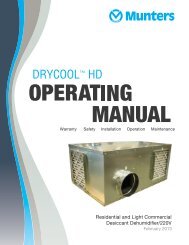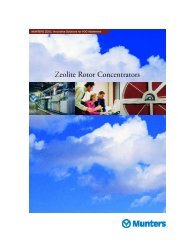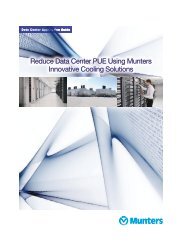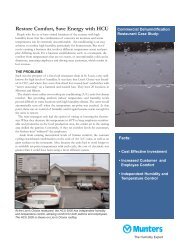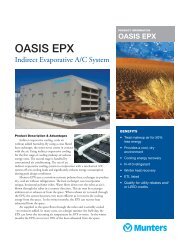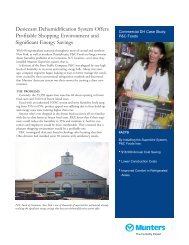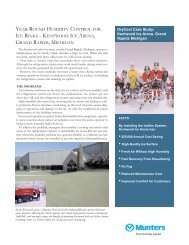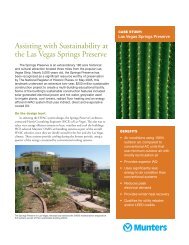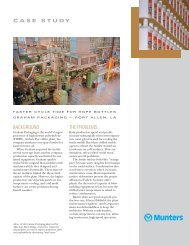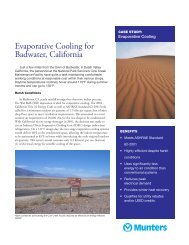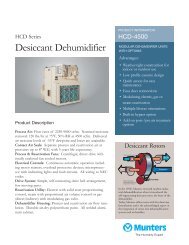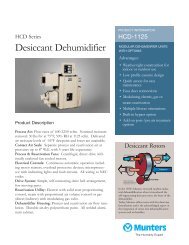Application Analysis: Meat and Poultry Processing - Level 2 - Munters
Application Analysis: Meat and Poultry Processing - Level 2 - Munters
Application Analysis: Meat and Poultry Processing - Level 2 - Munters
You also want an ePaper? Increase the reach of your titles
YUMPU automatically turns print PDFs into web optimized ePapers that Google loves.
Dehumidification Division - Industrial<br />
<strong>Application</strong> <strong>Analysis</strong>:<br />
<strong>Meat</strong> <strong>and</strong> <strong>Poultry</strong> <strong>Processing</strong> - <strong>Level</strong> 2
<strong>Application</strong> <strong>Analysis</strong>:<br />
<strong>Meat</strong> <strong>and</strong> <strong>Poultry</strong> <strong>Processing</strong> (<strong>Level</strong> II)<br />
Design<br />
Concerns<br />
From the eviscerating area to the<br />
cut-up room to the loading dock,<br />
the key to condensation control in<br />
meat <strong>and</strong> processing facilities is to<br />
blanket the targeted surfaces with<br />
dry air. Focus the solution at the<br />
source of the problem.<br />
For many condensation control<br />
situations the distribution of the<br />
dry air is as important as the supplied<br />
volume <strong>and</strong> humidity (dew<br />
point) level. Success comes from<br />
balancing the need to keep overhead<br />
surfaces dry against the risk<br />
of drying out the product being<br />
processed below.<br />
Control <strong>Level</strong><br />
Production<br />
In a typical production area the<br />
target set point for condensation<br />
control is fairly simple to identify<br />
– the delivered dew point must be<br />
less than the surface temperature<br />
of the components that are experiencing<br />
external condensation.<br />
Obtain surface temperatures of<br />
evaporators, ammonia lines, drain<br />
pans, etc. <strong>and</strong> select the lowest<br />
temperature, or slightly below it,<br />
as the target dew point.<br />
<strong>Application</strong> Note - <strong>Level</strong> II Page 2<br />
Sanitation<br />
Every evening the entire production<br />
floor goes through an extensive<br />
sanitation cycle with every<br />
surface in the facility being hosed<br />
down with high temperature,<br />
high-pressure water or steam.<br />
Processors are not expected to<br />
have zero condensation during<br />
sanitation. However, after<br />
sanitation is complete the processor<br />
must pass a USDA Pre-Op<br />
inspection before the next production<br />
shift can start. Water <strong>and</strong><br />
condensation must be removed<br />
from every surface before the<br />
facility passes this inspection.<br />
The objective of a condensation<br />
control system in this case is to<br />
reduce turnaround time. The<br />
same system parameters that meet<br />
the condensation control requirements<br />
during production likely<br />
will be sufficient for the post-sanitation<br />
mode as well. Some customers<br />
have incorporated a purge<br />
or washdown mode into their air<br />
h<strong>and</strong>ler design to facilitate the<br />
purging of the production areas of<br />
fog, condensation, <strong>and</strong> steam.<br />
See Design Considerations for<br />
additional information.<br />
Ice Prevention<br />
In some ice prevention applications,<br />
the temperature is so low<br />
that it would be economically<br />
impractical to maintain the dew<br />
point low enough to prevent all<br />
ice formation. In those cases,<br />
determine what is economically<br />
practical, <strong>and</strong> expect that there<br />
will be some ice formation, but<br />
at a much reduced rate. Setting<br />
reasonable <strong>and</strong> achievable performance<br />
expectations with the<br />
customer is key to success in this<br />
application.
Loads<br />
Moisture comes from several<br />
sources in meat <strong>and</strong> poultry facilities<br />
– infiltration, evaporation off<br />
wet surfaces, product load, <strong>and</strong><br />
personnel.<br />
Infiltration Air<br />
Outside air entering the controlled<br />
space is one of the two<br />
largest moisture loads. Large<br />
volumes of air (often in excess of<br />
100,000 scfm) are pulled through<br />
the facility in a counter flow direction<br />
(opposite to product flow)<br />
from clean to dirty (see Figure 1).<br />
This results in large amounts of<br />
untreated outside air (OA) being<br />
brought into processing areas with<br />
temperatures that can be 50˚F or<br />
lower.<br />
If 100,000 scfm of untreated<br />
outside summer air (in Atlanta,<br />
GA for example) infiltrates into a<br />
processing facility then approximately<br />
600 gallons of water per<br />
hour would condense on surfaces<br />
that are ≤50˚F. The magnitude of<br />
this moisture load justifies a thorough<br />
evaluation <strong>and</strong> optimization<br />
of the facility’s outside air requirements<br />
by a qualified engineer. A<br />
condensation control system then<br />
can be designed <strong>and</strong> integrated<br />
within the overall facility plan.<br />
Evaporation off Wet Surfaces<br />
A tremendous amount of water<br />
<strong>Application</strong> Note - <strong>Level</strong> II Page 3<br />
is utilized in a meat <strong>and</strong> poultry<br />
processing facility. Water is constantly<br />
being used to hose down<br />
floors <strong>and</strong> equipment <strong>and</strong> is the<br />
typical cooling medium for lowering<br />
the product temperature to<br />
regulatory limits. Approximately<br />
8 gallons of water are required per<br />
bird for complete processing. For<br />
a facility that processes 300,000<br />
birds per day the total water<br />
consumption exceeds 2 million<br />
gallons.<br />
Of course not all of this water<br />
evaporates into the controlled<br />
space. Quite a lot of the water<br />
is captured in floor drains <strong>and</strong><br />
pumped out of the plant. However,<br />
it is reasonable to assume<br />
that nearly every square foot of<br />
floor space has a thin film of water<br />
on it, <strong>and</strong> plant personnel are<br />
constantly replenishing the water<br />
film through steady spraying.<br />
Furthermore, unless the plant<br />
Outside Air<br />
Figure 1<br />
Shackling<br />
Pick / Scald<br />
Evisceration &<br />
Chilling<br />
operates in a perpetual 100% RH<br />
condition (fog) then there must<br />
be a differential vapor pressure<br />
between the water surface <strong>and</strong> the<br />
surrounding air. As a result there<br />
is a continuously high evaporation<br />
load off the floor <strong>and</strong> other<br />
wet surfaces.<br />
Additional evaporation occurs<br />
from bird chillers. In poultry<br />
facilities the bird core temperature<br />
is lowered to regulatory limits (≤<br />
40˚F) by immersing the product<br />
in large, water filled chillers.<br />
These chillers contain 35˚F water<br />
that is constantly being agitated<br />
with an auger or paddles that drag<br />
the product from one end of the<br />
chiller to the other.<br />
Product Moisture<br />
The product itself is a source of<br />
moisture after it exits the bird<br />
chiller. It has a thin film of water<br />
Conventional <strong>Poultry</strong> Plant Configuration<br />
(Before Condensation Control System)<br />
(-)<br />
Large<br />
negative<br />
airflow<br />
Exhaust Fans<br />
Cut-up<br />
Leakage<br />
(infiltration)<br />
Debone<br />
First <strong>Processing</strong> Second <strong>Processing</strong><br />
Airflow<br />
Packing,<br />
Cooler &<br />
Shipping<br />
Further <strong>Processing</strong> = breading, cooking (not shown)
over the entire surface that will<br />
evaporate due to differential vapor<br />
pressures between the surface <strong>and</strong><br />
the surrounding environment.<br />
One of the challenges that the<br />
system must address is the critical<br />
balance of preventing condensation<br />
against over drying the<br />
product.<br />
Personnel<br />
The processing of meat <strong>and</strong><br />
poultry is a labor intensive operation.<br />
There are workers hanging<br />
product on the line, hosing down<br />
the floors, eviscerating, cutting<br />
<strong>and</strong> deboning the product, <strong>and</strong><br />
packing the finished product into<br />
boxes. At any given time there<br />
are likely to be one to two hundred<br />
workers on the production<br />
floor. Within the context of the<br />
major load sources noted above,<br />
however, the moisture load contribution<br />
from personnel respiration<br />
is not likely to significantly<br />
affect the final equipment sizing<br />
<strong>and</strong> component selection.<br />
Space Temperature<br />
There are several steps involved<br />
in the processing of meat <strong>and</strong><br />
poultry products. Typically, the<br />
process starts out at elevated temperatures<br />
(70-80˚F) during the<br />
slaughter, hide or feather removal,<br />
<strong>and</strong> evisceration stages. The carcass<br />
then moves into increasingly<br />
cooler environments (~50˚F) for<br />
the subsequent steps (cut-up,<br />
debone, pack-out, etc.).<br />
<strong>Application</strong> Note - <strong>Level</strong> II Page 4<br />
There are a couple reasons for the<br />
drop in temperature as the process<br />
continues. In the case of poultry<br />
processing, for example, the primary<br />
driver is USDA regulations<br />
that require the core temperature<br />
of the product to be ≤ 40˚F by<br />
the time it leaves the facility. This<br />
is the reason for the bird chiller<br />
noted earlier. The core temperature<br />
is lowered below the regulated<br />
40˚F temperature after being<br />
immersed in the bird chiller for<br />
90 minutes. The low core temperature<br />
is established with food<br />
safety in mind since low temperatures<br />
retard bacteria / allergen<br />
growth. If the product must be at<br />
a low temperature then the space<br />
in which it is being processed also<br />
must be cool to prevent raising<br />
the product temperature above set<br />
point.<br />
Traditionally, the upstream<br />
processes (slaughter, hide/feather<br />
removal, <strong>and</strong> evisceration) are<br />
conducted in unconditioned<br />
areas. Some evisceration spaces<br />
are conditioned, but this appears<br />
to be driven more by worker comfort<br />
issues than by regulations.<br />
All of the further processing steps<br />
(cut-up, debone, pack-out, etc.)<br />
are performed in areas maintained<br />
at 50˚F.<br />
The most common method of<br />
temperature control in the conditioned<br />
spaces is through the use<br />
of ammonia evaporators installed<br />
near the ceiling. They are selfcontained<br />
units with blowers <strong>and</strong><br />
vanes to distribute the cold air<br />
across the ceiling.<br />
System Components<br />
& Design Considerations<br />
Process <strong>and</strong> Reactivation<br />
Filters<br />
Whether the system is designed<br />
for return air, outside air or a<br />
combination of both it is likely<br />
that high dust levels will be present<br />
on both airstreams of the desiccant<br />
wheel. <strong>Meat</strong> <strong>and</strong> poultry<br />
processes are typically dust-laden<br />
operations. Reactivation inlet<br />
filters should be at least 30%,<br />
possibly supplemented with 55%<br />
filters if the system is installed<br />
near the very dusty live loading /<br />
slaughter process.<br />
Systems designed to h<strong>and</strong>le<br />
return air should have 30/55%<br />
process air prefilters at a minimum<br />
due to the presence of<br />
particulate loads <strong>and</strong> oils. Supply<br />
air postfilters should be rated for<br />
95% efficiency unless the client<br />
requires HEPA filtration.<br />
Reactivation Energy<br />
Reactivation energy must be<br />
proportional to the moisture<br />
load. Since there is a large internal<br />
moisture load that is not<br />
weather dependent (evaporation<br />
off wet surfaces) the load will be<br />
relatively constant all year long.<br />
This means the designer should<br />
size the reactivation heaters based<br />
on the air entering temperature in
the winter rather than the summer.<br />
Otherwise, the heaters will<br />
lack capacity to fully reactivate<br />
the unit.<br />
Washdown during sanitation has<br />
important implications for the<br />
sizing of the reactivation heaters.<br />
A dehumidifier sized for a smaller<br />
“running load” of st<strong>and</strong>ard operating<br />
conditions must remove this<br />
large, intermittent moisture load.<br />
So a larger heater selection is<br />
justified but a modulating heater<br />
control with high turndown capability<br />
should be specified. This<br />
will prevent the extra capacity of<br />
the heater from wasting energy<br />
during normal operations.<br />
Materials of Construction<br />
The USDA subjects the meat<br />
<strong>and</strong> poultry processing environment<br />
to regular washdowns.<br />
Some customers are electing<br />
to purchase equipment with<br />
washdown capabilities because<br />
the equipment is servicing a<br />
processing area , even though the<br />
equipment is located outside the<br />
controlled space.<br />
For this reason, condensation<br />
control systems have been designed<br />
with the double-wall, nothrough<br />
metal platform. Stainless<br />
steel interior surfaces are typical<br />
<strong>and</strong> floor drains should be evaluated<br />
for all component plenums.<br />
Outside Air vs. Return Air<br />
In many meat <strong>and</strong> poultry<br />
<strong>Application</strong> Note - <strong>Level</strong> II Page 5<br />
processing facilities there is a large<br />
amount of outside air required to<br />
meet several facility constraints.<br />
Among these constraints are outside<br />
air requirements to make-up<br />
for process equipment exhaust<br />
<strong>and</strong> to dilute CO 2 <strong>and</strong> chlorine<br />
levels.<br />
The first step in the overall solution<br />
for the facility is to determine<br />
<strong>and</strong> optimize outside air<br />
requirements. Once the outside<br />
air requirement has been estimated<br />
then it can be compared to the<br />
airflow required for condensation<br />
control. The larger of the two<br />
airflow requirements establishes<br />
the total airflow for the HVAC<br />
system. Return air is required if<br />
the outside air volume is less than<br />
the total airflow. Since the outside<br />
air component is less than the<br />
total flow there must be a return<br />
air mixing box designed into the<br />
system.<br />
To facilitate the sanitation process<br />
(<strong>and</strong> reduce the pulldown<br />
time) some meat <strong>and</strong> poultry<br />
processors incorporate a purge<br />
or washdown mode into their<br />
HVAC systems. Regardless of<br />
the previous mode of operation<br />
(100% return air, 100% outside<br />
air or combination of both), the<br />
system switches to 100% outside<br />
air operation. Return air dampers<br />
shut, outside air dampers open,<br />
<strong>and</strong> an exhaust fan is energized.<br />
Depending on the system requirements<br />
the exhaust fan may pull<br />
more air from the conditioned<br />
space in the purge mode than<br />
during the operating mode. The<br />
idea is to evacuate as much of the<br />
water <strong>and</strong> steam-laden air from<br />
the facility as possible. The exhaust<br />
fan may operate on a VFD<br />
or multi-speed controller.<br />
Pre-/Post-Cooling<br />
Determining if pre-cooling <strong>and</strong>/<br />
or post-cooling is required will<br />
vary <strong>and</strong> needs to be determined<br />
on a case-by-case basis. If a 100%<br />
outside air system is required then<br />
it is safe to design pre-cooling<br />
into the system. Most likely an<br />
ammonia system will be utilized<br />
at the plant so an appropriate<br />
coil construction is warranted.<br />
Determine if the facility has a<br />
coil specification or st<strong>and</strong>ard that<br />
needs to be incorporated. Target<br />
a leaving air temperature of 45-<br />
50˚F off of the cooling coil.<br />
Conversely, return air systems<br />
may not require pre-cooling,<br />
especially in the downstream,<br />
temperature controlled processes.<br />
With 50˚F air returning to the<br />
system then adequate dew point<br />
depression can be achieved with<br />
no additional pre-cooling. However,<br />
if an outside air component<br />
is needed for any reason (process<br />
equipment exhaust, CO 2 or<br />
chlorine control, etc.) then the<br />
system may need to incorporate a<br />
pre-cool coil to reduce the process<br />
inlet air temperature to 45-50˚F.<br />
Evaluate the costs <strong>and</strong> benefits of<br />
pre-cooling the outside air only<br />
versus the blended air.
Post-cooling requirements are<br />
another challenge. The introduction<br />
of low dew point air into<br />
a moisture-laden environment,<br />
like that of a meat <strong>and</strong> poultry<br />
processing operation, has several<br />
advantages.<br />
First, the dew point differential<br />
provides a buffer against condensation<br />
for any low temperature<br />
surface. Second, evaporative<br />
cooling occurs. As mentioned<br />
previously, there is an almost<br />
infinite moisture load provided<br />
by the constant washing of floors<br />
<strong>and</strong> equipment in these facilities.<br />
Furthermore, energy is required<br />
to evaporate water <strong>and</strong> change its<br />
state from liquid to vapor.<br />
So, for every pound of water that<br />
evaporates into the processing<br />
space, approximately 1000 Btu<br />
is consumed, thereby cooling the<br />
environment by this amount. So,<br />
although a desiccant based system<br />
without post-cooling likely would<br />
deliver air at an elevated temperature<br />
(90-100˚F) to a processing<br />
space, the evaporative cooling<br />
effect significantly dampens the<br />
impact on space temperature.<br />
Again, a case-by-case approach is<br />
warranted, but post-cooling may<br />
not be required on any particular<br />
project.<br />
UV Lights<br />
The food processing industry has<br />
a strong emphasis on food safety.<br />
Sanitary facility <strong>and</strong> equipment<br />
design practices are being pro-<br />
<strong>Application</strong> Note - <strong>Level</strong> II Page 6<br />
moted through various industry<br />
channels including engineering<br />
committees that act as liaisons<br />
between the industry <strong>and</strong> its<br />
regulatory agencies. Within the<br />
processing areas there is heightened<br />
awareness on sanitizing any<br />
surface or equipment that has<br />
direct product contact. For this<br />
reason consideration needs to be<br />
given to incorporating a UV light<br />
section in the condensation control<br />
system as a means of meeting<br />
this increasingly likely industry<br />
requirement.<br />
Other Considerations<br />
• System maintenance:<br />
This is critical for condensation<br />
control systems. Inherently very<br />
dusty <strong>and</strong> dirty environments<br />
place a burden on regular filter<br />
maintenance <strong>and</strong> replacement.<br />
Filter clog alarms (photohelic<br />
gauges) should be considered<br />
to aid the facility’s maintenance<br />
staff. It is not uncommon for a<br />
facility to experience a spike in<br />
their airborne particulate <strong>and</strong><br />
cause premature loading of the<br />
system filters. Filter clog alarms<br />
provide advance warning to the<br />
staff should this occur in between<br />
their regular filter replacement<br />
schedule.<br />
Also, the most common time<br />
of the day for performing maintenance<br />
is when the systems are<br />
OFF, <strong>and</strong> at many facilities this<br />
is in the middle of the night.<br />
Therefore, plenum lights are<br />
recommended to provide the<br />
maintenance staff with adequate<br />
lighting. At a minimum, GFI<br />
receptacles should be provided so<br />
the staff can bring drop lights to<br />
the system.<br />
• Coil design:<br />
Attention needs to be given<br />
to the ammonia coil design as<br />
mentioned previously. Identify if<br />
the plant has a coil construction<br />
specification that needs to be followed.<br />
Remember that existing<br />
industry st<strong>and</strong>ards may be driven<br />
by the fact that low temperature<br />
evaporator coils are subject to<br />
freezing. As a result, fin spacing<br />
may be very low (4 to 6 fins per<br />
inch) to facilitate ice removal <strong>and</strong><br />
cleaning. Likewise, coil depth is<br />
frequently kept below 6 rows.<br />
If the condensation control system<br />
is properly designed, however,<br />
there should be little risk of ice<br />
formation on coils that are in the<br />
conditioned space. Proper filter<br />
maintenance will keep the coils<br />
clean. Therefore, smaller, more<br />
cost effective coils are likely available<br />
if the customer or engineer<br />
permits higher fin spacing.<br />
If coils are incorporated into the<br />
condensation control system then<br />
connection details need to be<br />
specified (flanged, stubbed, materials<br />
of construction, etc.).<br />
Controls<br />
In many meat <strong>and</strong> poultry processing<br />
applications the conden-
sation control system operates<br />
at full capacity. With the high<br />
internal moisture load inherent<br />
in many processes there is usually<br />
low risk of over drying the<br />
controlled space. If the desiccant<br />
wheel is not sized to h<strong>and</strong>le the<br />
entire system airflow then a fixed<br />
bypass is sufficient.<br />
If a particular project needs<br />
tighter humidity control then a<br />
modulating feature needs to be<br />
incorporated. This feature can<br />
modulate a face & bypass configuration<br />
on the process air stream<br />
or reactivation energy. In either<br />
scenario a rise in humidity above<br />
set point triggers increased dehumidification<br />
(by opening the face<br />
damper <strong>and</strong> closing the bypass<br />
damper or increasing reactivation<br />
energy). The reverse occurs<br />
upon a drop in humidity below<br />
set point.<br />
Cost Considerations<br />
Minimizing the installed cost of<br />
the system is largely a question of<br />
eliminating unnecessary moisture<br />
loads. There is little that can be<br />
done to reduce the evaporation<br />
load off wet surfaces since water<br />
consumption is critical to the<br />
process.<br />
The biggest overall variable that<br />
the system design can address is<br />
the outside air infiltration load.<br />
The individual systems requiring<br />
outside air (CO 2 <strong>and</strong> chlorine<br />
control, equipment exhaust, etc.,)<br />
<strong>Application</strong> Note - <strong>Level</strong> II Page 7<br />
need to be evaluated <strong>and</strong> reduced<br />
as much as possible. If any particular<br />
system requires a disproportionate<br />
amount of outside air<br />
then separate, dedicated make-up<br />
air systems may be justifiable, especially<br />
in unconditioned areas of<br />
the facility that may not require<br />
desiccant-based solutions (see<br />
Figure 2).<br />
Operating costs can also be<br />
minimized through various design<br />
modifications. For example,<br />
energy recovery should be considered<br />
on 100% outside air systems<br />
since they are inherently energy<br />
inefficient. Many operations in a<br />
processing facility are performed<br />
in conditioned (≤50˚F) spaces.<br />
Before this conditioned air<br />
exits the space it can be brought<br />
Outside Air<br />
Figure 2<br />
Shackling<br />
(-)<br />
Smaller negative<br />
airflow<br />
Pick / Scald Evisceration &<br />
Chilling<br />
through a heat exchanger to precondition<br />
the entering air.<br />
It takes approximately 8 tons of<br />
refrigeration for every 1,000 scfm<br />
that is cooled from 95˚F, 130<br />
gr/lb to 50˚F. A 20,000 scfm system<br />
would require more than 160<br />
tons of cooling. Recovering just<br />
25% of this energy (a conservative<br />
estimate) would save 40 tons of<br />
cooling.<br />
One constraint of such a system<br />
is that the exhaust air needs to be<br />
brought to a single point to facilitate<br />
the energy exchange between<br />
the two airstreams. Any additional<br />
duct requirements need to<br />
be included in the cost-benefit<br />
analysis.<br />
Modified <strong>Poultry</strong> Plant Configuration<br />
(After Condensation Control System)<br />
MUA Unit<br />
- +<br />
RA<br />
OA<br />
Cut-up<br />
RA<br />
+<br />
DH<br />
-<br />
RA<br />
OA<br />
Airflow<br />
Debone Packing,<br />
Cooler &<br />
Shipping*<br />
* Served by separate, dedicated DH or MUA system
<strong>Munters</strong> is a global leader in<br />
energy efficient air treatment solutions.<br />
<strong>Munters</strong> manufactures engineered products that can economically control<br />
humidity <strong>and</strong> temperature, provide energy recovery, <strong>and</strong>/or utilize direct or<br />
indirect evaporative cooling for comfort, process <strong>and</strong> environmental protection.<br />
With permanent or temporary solutions, <strong>Munters</strong> offers a wide variety of<br />
options to meet specific climate, application <strong>and</strong> budget requirements.<br />
<strong>Munters</strong> has net sales approaching $1 billion USD with more than 20<br />
manufacturing facilities across the globe <strong>and</strong> sales offices in over 30 countries.<br />
<strong>Munters</strong> employs approximately 4,300 people worldwide.<br />
For more information see www.munters.us<br />
<strong>Munters</strong> Corporation<br />
Tel: (800) 843-5360 E-mail: dhinfo@munters.com www.munters.us<br />
AG0019-00 03/09



